engine AUDI A6 2017 Workshop Manual
[x] Cancel search | Manufacturer: AUDI, Model Year: 2017, Model line: A6, Model: AUDI A6 2017Pages: 280, PDF Size: 70.24 MB
Page 194 of 280

Checking and Filling
These fuel s contain substances that can se
verely damage the fue l system and the en
gine if the engine is started .
Refueling
Fuel filler neck
The fuel fille r neck is located on the r ight rear
side pane l beh ind the f uel fi ller flap.
If the power locking system should fail , you can
still open the flap manua lly - for deta iled instruc
tions see~
page 194 .
You can find the fuel tank capac ity of your vehicle
i n
~ page 257 .
The label on the inside of the fuel filler flap tells
you the correc t fuel for your vehicle . For more in
formation about fue l specifications , see
~ page 190 .
Your veh icle fuel t ank has an onboard refuelling
vapor recovery sys tem . This fea tu re he lps to pre
vent fuel vapors from escaping from the tank and pollut ing the env ironment while you refuel your
ve hicle. In order to fill the tank prope rly while
p rotecting the environment, please fo llow this
re fueling proce dure caref ully.
8_ WARNING
Under no rmal o perating conditions, never car
ry additiona l fuel containers in yo ur car. Gas
canisters and ot her containers used to trans
port fuel can be dangerous . Such containers,
full or empty, may leak and could cause a fire
in a collision . If yo u must t ransport fue l to
use for yo ur lawn mower, snow blower, etc.,
be
very careful and a lways observe loca l and
s tate laws regar ding t he use, transportation
a nd sto rage of s uch fue l conta iners. Make ce r
t ain the con tainer mee ts in dust ry sta ndards
(A NSI/AS TM F8S 2 - 86) .
(D Note
Never d rive yo ur vehicle unt il t he fuel tan k is
c ompletely empty . T he irregu lar sup ply of
fue l can ca use m isfiri ng. Gasoline cou ld enter
t he exha ust system and damage the catalytic
converter.
192
Fueling procedure
Fi g. 17 4 R ig ht rea r side o f th e ve hicle: ope ning t he fuel
fi ll er door
Fig . 1 75 Fue l fill er doo r w it h at tac hed fu el cap
The fue l filler doo r is u nlocked or locked by the
central locking system .
Opening the fuel cap
" Press on the left side of the fue l filler door to
open
~ fig . 174.
"Unscrew the tank cap co unterclo ckwise .
" Place the cap from
above on the open f uel f iller
door
~ fig. 175 .
Closing the fuel cap
" Scr ew the tank cap on to the right on the filler
neck unt il it ca nnot turn any fart her .
" Then press on the left s ide of the t an k door un-
til it latches.
Once the pump no zzle switches off , t he fuel ta nk
i s "full ". Do not fill the tank mo re . O therwise the
expans io n sp ace in the tan k w ill be filled.
The co rrect fuel type for your vehicle can be
fo und o n a label located on the inside of the f uel
fille r door . Fo r addi tional informat io n on fuel,
see
~ page 190 .
Page 195 of 280
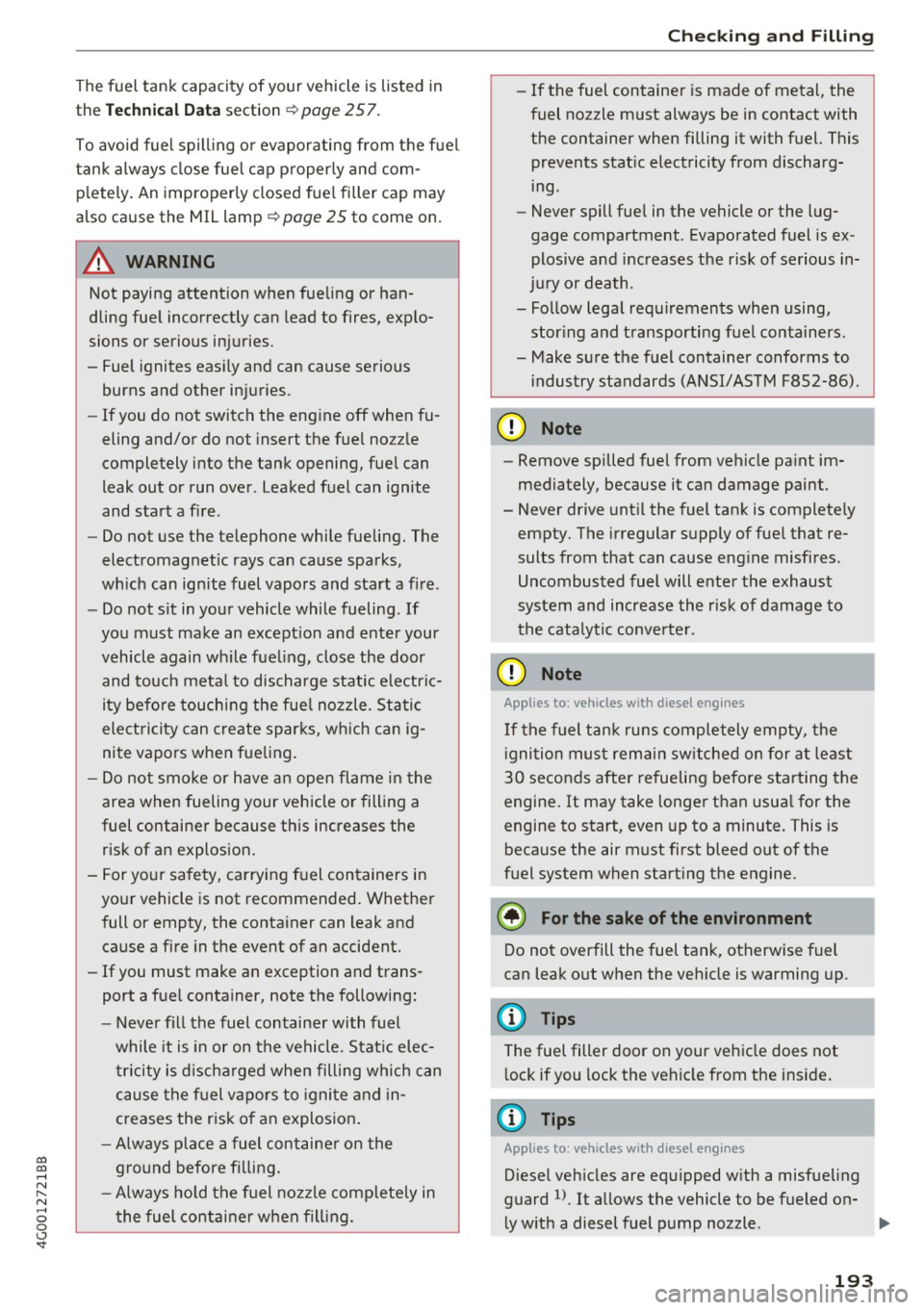
co
co
.... N
" N .... 0 0 <..:l '
the
Tech nical D ata s e ction ¢ page 257.
To avoid fuel spill ing or evaporating from the f uel
tank always close fuel cap p roperly and com
p letely. An improperly closed fue l filler cap may
also cause the MIL lamp
r:!> pag e 25 to come on.
A WARNING
Not paying attention when fueling or han
dling fuel incorrectly can lead to fires, exp lo
sions or serious in juries.
- Fuel ignites easily and can cause serious burns and other injuries .
- If you do not switch the eng ine off when fu
eling and/or do not insert the fuel no zzle
completely into the tank opening, fue l can
leak out or run over . Leaked fuel can ignite
and start a fire .
- Do no t use the telephone while fueling. The
electromagnet ic rays can cause sparks,
wh ich can ignite fuel vapors and start a fire .
- Do not s it in your vehicle while fueling . If
you must make an except ion and enter your
vehicle again wh ile fue ling , close the door
and touch meta l to discha rge static electric
ity befo re touching the fue l nozzle . Static
electricity can create spar ks, wh ich can ig
ni te vapors when fue ling.
- Do not smoke or have an open flame i n the
area when fueling your vehicle or filling a
fuel container because this increases the
risk of a n explosion .
- For your safety , carrying fuel containers in
your vehicle is not recommended . Whether
full or empty, the container can leak and cause a fire in the event of an accident.
- If you must make an exception and trans
port a fuel container, note the following:
- Never fill the fuel containe r with fuel
while it is in or on the vehicle. Stat ic elec
tr icity is d ischa rged when filling wh ich can
cause the f uel vapors to ignite and in
creases the risk of an explos ion .
- Always p lace a fuel containe r on the
g round before fi lling .
- Always ho ld the fuel no zzle comp letely in
the fuel container when filling.
Ch eck ing and Filling
-If the fuel container is made of metal, the
fuel nozzle must always be in contact with
the container when filling it with fuel. This prevents stat ic electricity from discharg
ing .
- Never spill fue l in the vehicle or the lug
gage compartment. Evaporated fuel is ex
plosive and increases the risk of serious in
ju ry or death .
- Follow legal req uirements when using,
stor ing and transporti ng fuel containers.
- Make sure the fuel container conforms to
industry standards (ANSI/ASTM F852-86).
CD Note
- Remove spilled fuel from vehicle pa int im
mediately , because it can damage paint.
- Never drive unt il the fuel tank is complete ly
empty. The irregular supply of fue l that re
sults from that can cause eng ine misfires .
Uncombusted fuel will enter t he exhaust
system and increase the risk of damage to
the catalyti c converter .
CD Note
Applies to: vehicles with diesel engines
If the f uel tank ru ns completely empty, the
i gni tion must remain sw itched on for a t least
30 seco nds after refueling before sta rting the
engine . It may take longer than usua l for the
engine to start, even up to a minute. This is
because the air must first bleed out of the
fuel system when start ing the engine .
@ For the sake of the environment
Do not overfill the fuel tank, otherwise fuel
can leak out when the veh icle is warming up.
(D Tips
The fuel filler door on your vehicle does not l ock if you lock the ve hicle from the ins ide.
(D Tips
Applies to: vehicles with diesel e ngin es
Diesel veh icles are equipped w ith a misfueling
guard
l )_ It a llows the vehicle to be fueled on-
l y w ith a diesel fuel p ump nozzle .
IJJ,,
193
Page 197 of 280

co
co
.... N
" N .... 0 0 <.,;) 'SI'
-Ad Blue is req uired by law to operate this ve
hicle .
Messages in the instrument cluster display
Appl ies to: ve hicles with selective ca talytic reduc tion
The display indicates if the Ad Blue level is low or
if there is a system malfunction.
AdBlue level low
You wi ll be informed if the Ad Blue in t he tank
dr ops below a certain leve l.
Please r efill Ad B lu e. Rang e x mi (km )
This message appears when there is only enough
Ad Blue left to drive the distance indicated in the
driver information system . Fill the AdBlue.
Ad Blue /9 Refill AdBlue! Cannot start engine
in x mi (x km )! See owner 's m anual
This message appea rs when there is only eno ugh
Ad Blue left to d rive the distance indicated in the
driver information system. Fill the AdBlue. Other
wise the engine will not start again if you stop it
once the distance ind icated has been driven. You
can also check the remaining distance in the on
board computer*.
Refill AdBlue! No restart! See o wn·
er 's manual
This message appears when the AdBlue tank is
empty. Fill the Ad B lue . Otherwise you will not be
ab le to start the engine again once you stop it.
The AdB lue m ust be refilled when the amount in
the tank has reached the minimum level
¢ page 195, Filling Ad Blue .
Incorrect filling/system malfunction
A message appears if the Ad Blue tank was filled
with a fluid other than AdBl ue and the sys tem
h as detec ted t hat the tank was f illed incorrect ly,
or if there is a system malfunction .
Ad Blue/ AdBlue : system fault . No restart in
x mi (x km ) See owner 's manu al
This message appears when it is only poss ible to
drive the d ista nce ind icated in the dr iver informa
tion system. Drive to t he nearest autho rized Aud i
dealer or authorized Aud i Serv ice Facility to have
Checking and Filling
the mal func tion corrected. Otherw ise the engine
will not sta rt again if you stop it once the dis
tance indicated has been driven .
Ad Blue: Syst em fault No re start!
See owne r's ma nual
T his message appears if the system has detected
that the tan k was fi lled incorrect ly or tha t there
is a ma lf u nction. Drive immed iate ly to the nea r
est authorized A udi dealer or authorized Audi
Service Facility to have the malfunction correct
ed. Otherwise you will not be able to start the en
gine again once you stop it .
Filling AdBlue
Applies to : vehicles wi th selective cat alyt ic re du ctio n
Fi g. 17 8 Right rear side of the vehicle: removing t he AdBl
ue cap
The Ad Blue tank open ing is located near the d ie
se l tank opening . Add at least 1.5 gallons (5 . 7
li te rs) of Ad Blue. This is the m inimum amo unt re
quired to ensure the system detects the refilling
and to start the eng ine. You can add a max imum
of4.5 gallons ( 17 liters).
Requirement: the request to add Ad Blue mus t
appea r in the ins trument clus ter display.
.,. Switch the ignit ion off .
.,. Open the tank filler door ¢
page 192.
.,. Tur n the cap on the f iller ne ck coun ter-clock
w ise using the wheel wre nch from the vehi cle
too l kit to remove it¢
fig . 178.
.,.. Fill the AdBlue using a bottle ¢ page 196 or a
canister
¢page 196. ..,.
195
Page 198 of 280
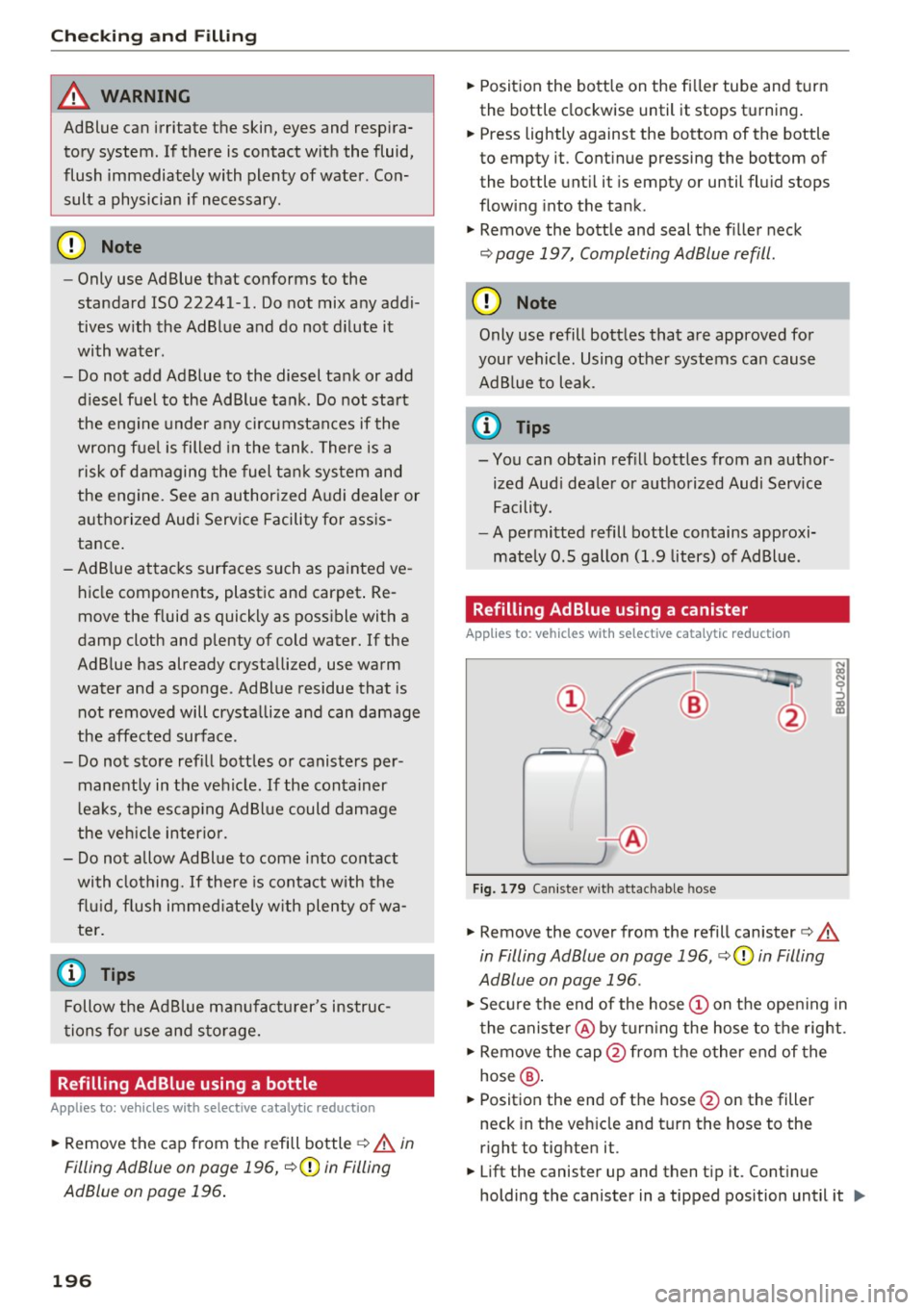
Checking and Filling
& WARNING
AdBlue can irritate the skin, eyes and respiratory system. If there is contact with the fluid,
flush immediately with plenty of water . Con
sult a physician if necessary.
(D Note
- Only use Ad Blue that conforms to the
standard ISO 22241 -1. Do not mix any addi
tives with the Ad Blue and do not dilute it
with water.
- Do not add Ad Blue to the diesel tank or add diesel fuel to the Ad Blue tank. Do not start
the engine under any circumstances if the
wrong fuel is filled in the tank. There is a
risk of damaging the fuel tank system and
the engine. See an authorized Audi dealer or
authorized Audi Service Facility for assis
tance.
- AdBlue attacks surfaces such as painted ve
hicle components, plastic and carpet. Re
move the fluid as quickly as possible with a
damp cloth and plenty of cold water. If the
Ad Blue has already crystallized, use warm
water and a sponge . AdBlue residue that is
not removed will crystallize and can damage
the affected surface.
- Do not store refill bottles or canisters per
manently in the vehicle. If the container
leaks, the escaping AdBlue could damage
the vehicle interior.
- Do not allow AdBlue to come into contact
with clothing. If there is contact with the
fluid , flush immediately with plenty of
wa
ter.
(j) Tips
Follow the Ad Blue manufacturer 's instruc
tions for use and storage.
Refilling AdBlue using a bottle
Applies to: vehicles with selective catalytic reduction
... Remove the cap from the refill bottle ¢.&. in
Filling AdBlue on page 196,
c::> (D in Filling
AdBlue on page 196.
196
... Position the bottle on the filler tube and turn
the bottle clockwise until it stops turning.
... Press lightly against the bottom of the bottle
to empty it . Continue pressing the bottom of
the bottle until it is empty or until fluid stops
flowing into the tank .
... Remove the bottle and seal the filler neck
c::> page 197, Completing AdBlue refill.
d) Note
Only use refill bottles that are approved for
your vehicle. Using other systems can cause AdBlue to leak.
(D Tips
- You can obtain refill bottles from an author
ized Audi dealer or authorized Audi Service
Facility.
- A permitted refill bottle contains approxi
mately 0.5 gallon (1.9 liters) of AdBlue.
Refilling AdBlue using a canister
Applies to: vehicles with selective catalytic reduction
®
+®
Fig. 179 Canister w ith attachable hose
... Remove the cover from the refill canister c::> .&.
in Filling AdBlue on page 196 , c::>(D in Filling
AdBlue on page 196 .
.,. Secure the end of the hose
.,. Remove the cap @from the other end of the
hose @.
... Position the end of the hose @on the filler
neck in the vehicle and turn the hose to the
right to tighten it .
... Lift the canister up and then tip it . Continue
holding the canister in a tipped position until it
1J,,
Page 199 of 280
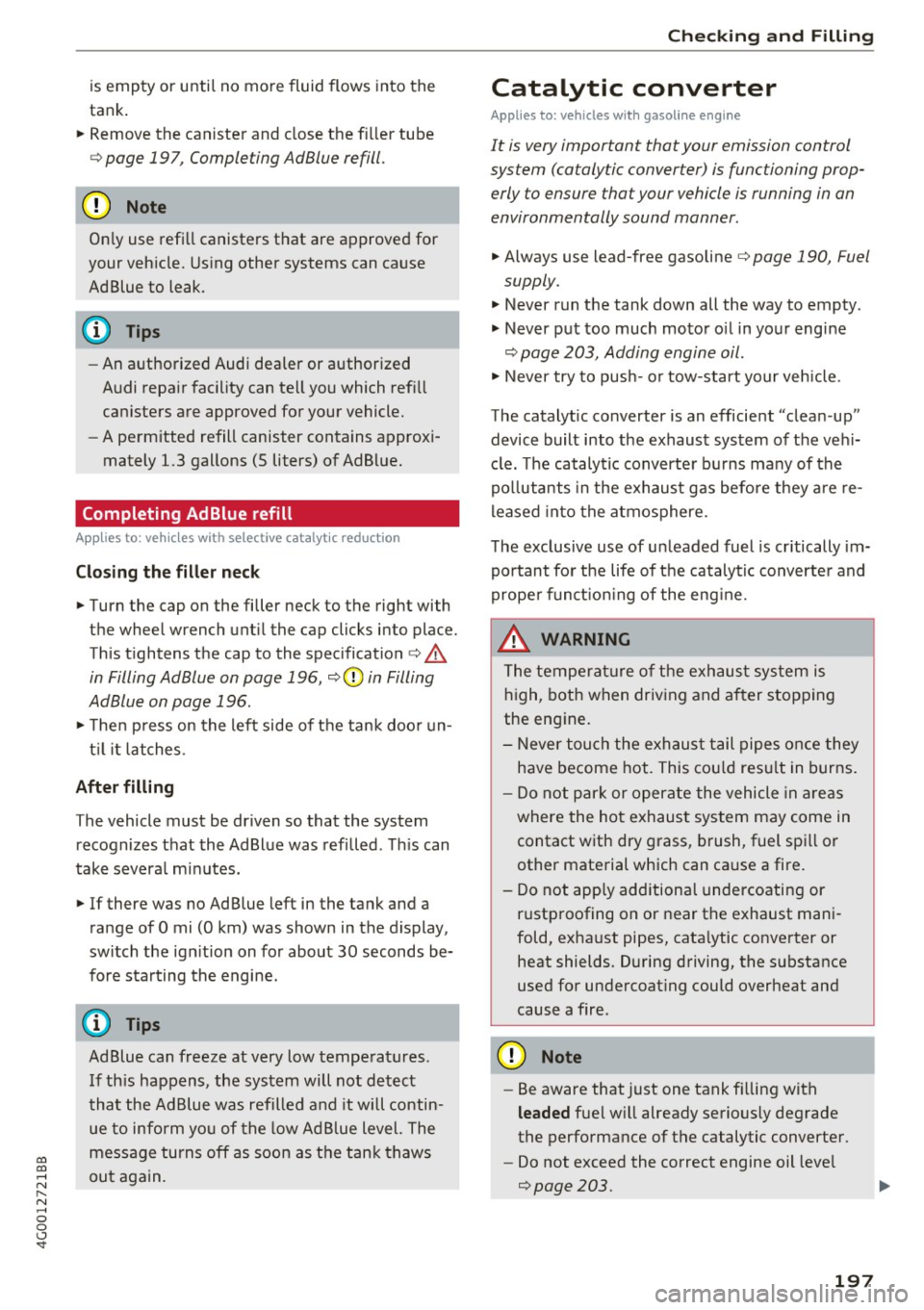
co
co
.... N
" N .... 0 0 <..:l -
tank .
.,. Remove the canister and close the fi ller tube
c:> page 197 , Comple ting AdBlue refill .
CD Note
Only use refi ll canisters that are approved for
your vehicle. Us ing other systems can cause
Ad Blue to leak.
(D Tips
- An authorized Audi dealer or authorized
Audi repair facility can tell you which ref ill
canisters are approved for your vehicle.
- A permitted refill canister conta ins approxi
mately 1.3 gallons (5 liters) of AdBlue.
Completing AdBlue refill
Applies to: vehicles with selective catalytic reduction
Clo sing the filler nec k
.,. Tu rn the cap on the filler neck to the right with
the wheel wrench until the cap clicks into place.
This t ightens the cap to the specification c::> .&.
in Filling AdBlue on page 196, c:> 0 in Filling
AdBlue on page 196.
.,. The n press on the left side of the tank doo r un-
t il it latches .
After filling
The vehicle must be dr iven so that the system
recognizes that the Ad Bl ue was refilled . Th is can
take severa l m inutes.
.,. If there was no Ad Blue left in the tank and a
range of O mi (0 km) was shown in the display,
switch the ign ition on for about 30 seconds be
fore starting the engine.
(D Tips
Ad Blue can freeze at very low temperatures.
If th is happens , the system will not detect
that the Ad Blue was refilled and it will contin
ue to inform yo u of the low Ad B lue level. The
message turns off as soon as the tank thaws
out again .
Ch eck ing and Filling
Catalytic converter
Applies to: vehicles with gasoline engine
It is very important that your emission control
system (cataly tic converter) is functioning prop
erly to ensure that your vehicle is running in an
environmentally sound manner.
.,. Always use lead-free gasoline c:> page 190 , Fuel
supply.
.,. Never run the tank down all the way to empty .
.,. Never put too much motor o il in your engine
c:> page 203, Adding engine oil.
.,. Never try to push- or tow-start your vehicle.
The catalytic co nverter is an efficient "clean -up"
device built into the exhaust system of the ve hi
cle. The catalyt ic converter b urns many of the
po llutants in the exhaust gas before they are re
leased into the atmosphere.
The exclusive use of un leaded fuel is cr itically im
portant for the life of the catalytic converte r and
prope r funct ion ing of the eng ine .
_&. WARNING
The tempera ture of t he exhaus t sys tem is
h igh, bot h when driv ing and a fter stopping
the engine .
- Never tou ch the exhaust tail pipes once they
have become hot. This cou ld resu lt in burns.
- Do not park or operate the vehicle in ar eas
where the hot exhaus t sys tem may come in
contact with dry grass, b rush, fuel spill or
other material which can ca use a fire.
- Do not app ly additiona l undercoating or
r u stp roofing on or near the exhaust mani
fold, exha ust pipes, cata lytic converter or
heat shields . D uring driving, the substance
used for undercoat ing could overheat and
cause a fire.
CD Note
- Be aware that just one tank fi lling with
leaded fuel w ill already seriously degrade
the performance of the catalytic converter .
- Do not exceed the correct engine oil leve l
c:> page 203.
197
Page 200 of 280

Check ing and F illing
- Do not drive until the fuel tank becomes
complete ly empty . The engine cou ld mis
fire . Unburned fuel could also get into the
exhaust system and this cou ld cause the
catalytic converter to overheat.
- Do not sw itch off the ignition while the vehi
cle is moving .
- Do not continue to operate your vehicle un
der these cond itions, as otherwise fuel can
reach the catalytic converter . This could re
su lt in overheating of the converter, requ ir
i ng its replacement .
- To assure efficient operation of the Emis
sion Control System :
- Have your ve hicle main tained pro perly and
in accordance with the service recommen
dations in your Wa rranty & Maintenance
book let.
- Lac k of proper maintenance as well as im
proper use of the vehicle will impair the
function of the emission cont rol system
and could lead to damage.
@ For the sake of the environment
Even when the Emission Control System is op
erat ing properly, the exhaust gas can have a
sulfur-like exhaust gas smell under some op
erat ing states . This depends on the su lfur
content of the fuel be ing used . Using a differ
ent brand of fue l may he lp, or filling the tan k
w ith lead-free super grade gasoline.
Diesel particulate filter
A ppl ies to: ve hicles w ith diesel e ng in e
The diesel particulate fi lter filters nearly all of
the soot particles out of the ex haust. The f ilter
cleans i tse lf automatically under normal d riv ing
conditions. If the filte r ca nnot clean itse lf (for e x
a mple , beca u se you are only driving sho rt distan
ces), the fi lter becomes clo gged with soot and
the . symbo l for the diesel particulate fi lter il
lum inates
c:> page 18.
A WARNING
- Do not park you r vehicle over flammable
materials such as grass or leaves because
198 -
the high temperature of the diesel particu
late filte r could sta rt a fire .
- Do not apply an underbody protectant in the
exhaust system area or a fire could sta rt.
Engine compartment
· Working in the engine compartment
Special care is required if you are working in the
engine compartment
For work in the engine compartment, such as
checking and fill ing fluids , the re is a risk of in
jury, scalding, accidents , and burns. For this
reason, follow all the warnings and general
safety precaut ions provided in the following in ·
formation . The engine compartment is a dan
gerous area on the vehicle.
c:> .&, .
A WARNING
-Turn the engine off.
- S witch t he igni tion off.
- Set the park ing bra ke .
- Select the P s elector lever position.
-Let the eng ine cool down .
- Never open the hood when there is steam o r
coo lant escaping from the engine compart
ment, because there is a risk that you could
be burned . Wait unt il no steam or coolant is
escaping .
- Keep children away from the eng ine com
pa rtment .
- Never sp ill fluids on a hot eng ine. These flu
ids (such as the freeze protection contained
in the coolant) ca n ca tch fire .
- Avoid short c ircuits in the electrical system .
- When working in the engine compa rtment,
remember that the radiator fan can switch
on even if the ignition is switched off, wh ich
increases the r is k of p ersona l injury.
- Never ope n the cap on the coolant expan
sion tank when the engine is warm . The
coo ling system is under p ressure .
- To protect your face, hands, and arms from ho t steam or coolant, cover the cap with a
large cloth wh en opening .
~
Page 201 of 280
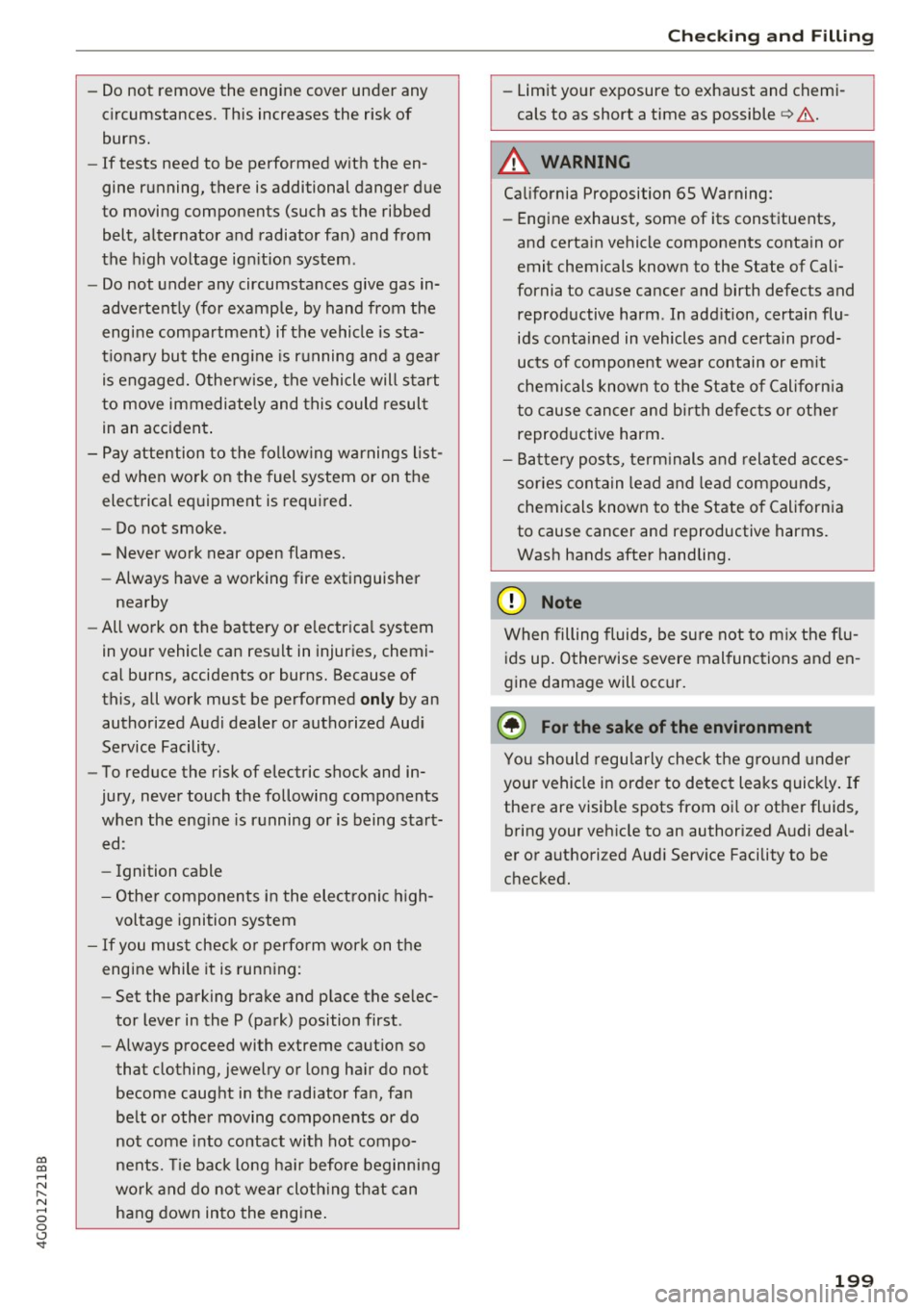
co
co
.... N
" N .... 0 0 <..:l '
circumstances . This increases the risk of
burns.
- If tests need to be performed with the en
gine running, there is additional danger due
to moving components (such as the ribbed belt, alternator and radiator fan) and from
the high voltage ignition system.
- Do not under any circumstances give gas in
advertently (for example, by hand from the
engine compartment) if the vehicle is sta
tionary but the engine is running and a gear
is engaged. Otherwise, the vehicle will start
to move immediately and this could result
in an accident.
- Pay attention to the following warnings list
ed when work on the fuel system or on the
electrical equipment is required.
- Do not smoke .
- Never work near open flames.
- Always have a working fire extinguisher
nearby
- All work on the battery or electrical system
in your vehicle can result in injuries, chemi•
cal burns, accidents or burns. Because of
this, all work must be performed
only by an
authorized Audi dealer or authorized Audi
Service Facility.
- To reduce the risk of electric shock and in
jury, never touch the following components when the engine is running or is being start
ed :
- Ignition cable
- Other components in the electronic high-
voltage ignition system
- If you must check or perform work on the
engine while it is running:
- Set the parking brake and place the selec
tor lever in the P (park) position first .
- Always proceed with extreme caution so
that clothing, jewelry or long hair do not
become caught in the radiator fan, fan
belt or other moving components or do not come into contact with hot compo
nents. Tie back long hair before beginning
work and do not wear clothing that can
hang down into the engine .
Checking and Filling
-Limit your exposure to exhaust and chemi
cals to as short a time as possible
c:> A .
A WARNING
-California Proposition 65 Warning:
- Engine exhaust, some of its constituents,
and certain vehicle components contain or
emit chemicals known to the State of Cali
fornia to cause cancer and birth defects and
reproductive harm . In addition, certain flu
ids contained in vehicles and certain prod
ucts of component wear contain or emit
chemicals known to the State of California
to cause cancer and birth defects or other
reproductive harm.
- Battery posts, terminals and related acces
sories contain lead and lead compounds,
chemicals known to the State of California
to cause cancer and reproductive harms. Wash hands after handling.
(D Note
When filling fluids, be sure not to mix the flu
ids up. Otherwise severe malfunctions and en
gine damage will occur.
@ For the sake of the environment
You should regularly check the ground under
your vehicle in order to detect leaks quickly. If
there are visible spots from oil or other fluids, bring your vehicle to an authorized Audi deal
er or authorized Audi Service Facility to be
checked.
199
Page 202 of 280

Checking and Filling
Opening/closing the hood
The hood is released from inside the vehicle .
Fig. 180 Driver footwell: release lever
Fig . 181 Rocker switch under the hood
Make sure the wiper arms are not raised up from
the windshield. Otherwise the paint could be
damaged .
Opening th e hood
• With the driver's door open, pu ll the lever be
low the instrument panel in the direction of the
arrow
c!;> fig. 180 .
200
• Raise the hood slightly c!;> &_ .
• Press the rocker switch under the hood upward
i=> fig. 181. This releases the catch.
• Open the hood .
Clos ing the hood
• Push the hood down until you override the
force of the s trut.
• Let the hood fall lightly into the latch .
Do not
press it in .
c> &_.
A WARNING
-Never open the hood when there is steam or
coolant escaping from the engine compart
ment, because there is a risk that you could
be burned. Wait unt il no steam or coolant is
escaping.
- For safety reasons, the hood m ust always be
closed securely while driv ing. Because of
this, always check the hood after closing it
to make sure it is latched correctly . The
hood is latched if the front corners cannot
be lifted.
- If you no tice that t he hood is not latched
while you are driving, stop immediate ly and
close it, because driving when the hood is
not latched increases the r isk of an accident.
Page 203 of 280
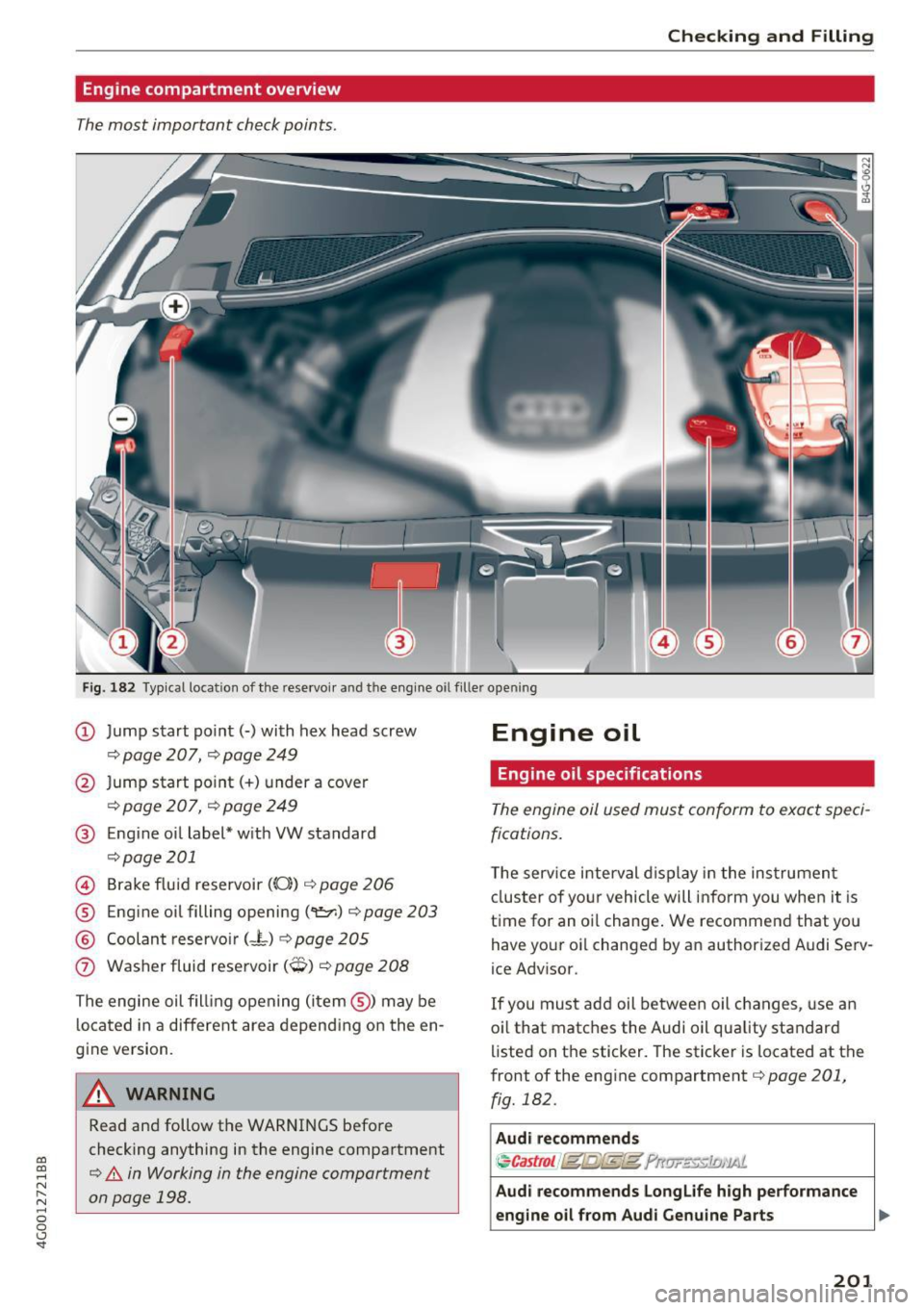
co
co
.... N
" N .... 0 0 <..:l 'SI'
Checking and Filling
Engine compartment overview
The most important check points .
Fig. 182 Typ ical locatio n of t he rese rvoi r and the engine o il filler opening
(D Jump start po int(-) with hex head screw
¢ page 207, ¢ page 249
@ J ump start point(+) under a cover
¢ page 20 7, ¢ page 249
® Eng ine oi l label* w ith VW standard
¢page201
© B rake fluid reservoi r (0)) ¢ page 2 06
® Eng ine oil filling opening ('t::r.) ¢ page 203
@ Coolant reservo ir (- L) ¢ page 205
0 Washer fluid rese rvoir (0) ¢ page 208
The engine oil fill ing opening (item@) may be
l oca ted in a different area depend ing on the en
g ine version.
A WARNING 1 =
Read an d follow the WAR NINGS befo re
checking anything in the engine compartment
¢ A in Working in the engine compartment
on page 198.
Engine oil
Engine oil specifications
The engine oil used mus t conform to exact speci
fications.
T he serv ice interv al d isplay in the instrument
cl uster of yo ur vehicle will inform you when it is
t ime for an oi l change. We recommend that you
have yo ur oil changed by an authorized Audi Serv
ice Adv isor.
If you mu st add oil betwee n oil c hanges, use an
o il that matches the Audi oil qua lity standard
li sted on the sticker. The sticker is located at the
front of the eng ine compartment ¢
page 201,
fig. 182.
Audi recommends
~Castrol / /gfj;;j;f!K[g Frtfl7?-:<:"£Jl.JAi.
Audi recommends Longlife high performance
eng ine oil from Aud i Genuine Parts
II>
201
Page 204 of 280
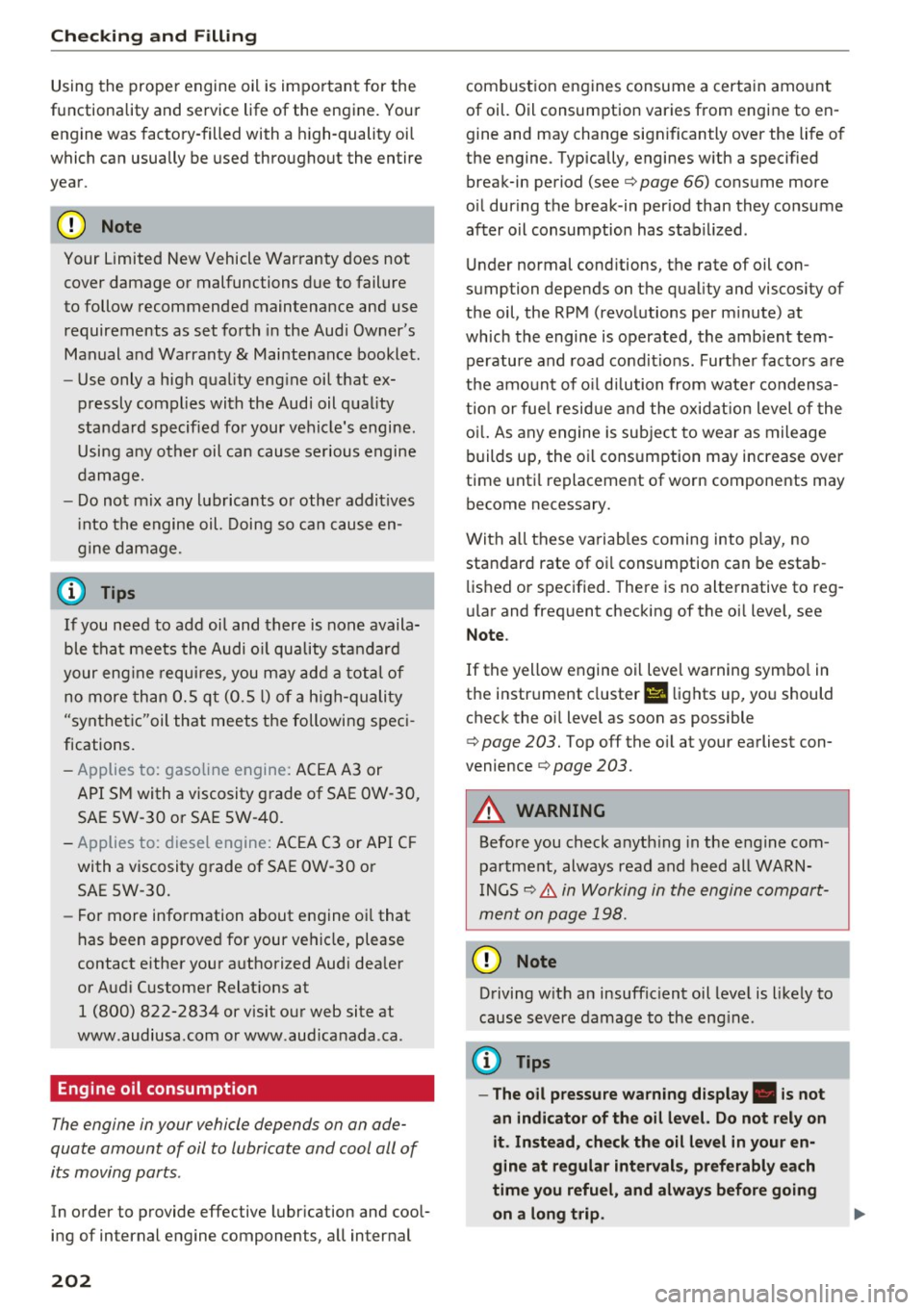
Check ing and F illing
Using the proper engine oil is impo rtant for the
functionality and service life of the engine. Your
engine was facto ry-filled with a h igh-quality oi l
which can usually be used throughout the entire
year.
@) Note
Your Limited New Vehicle War ranty does not
cover damage or malfunctions due to failure
to follow recommended maintenance and use
requirements as set forth in the Audi Owner's
Manual and Warran ty
& Maintenance booklet.
- Use only a high quality eng ine oil t hat ex-
p ressly complies with the Audi oil qua lity
standard specified for your vehicle's engine.
Using a ny o ther oil can cause serious engine
d am age.
- D o not mix any lubricants o r other addit ives
i nto the engine oil. Doing so ca n cause en
g ine damage.
(D Tips
I f you need to add oil and there is none availa
ble t hat meets the Audi o il quality standard
your eng ine requi res, you m ay ad d a tot al of
no more than 0.5 q t (0.5
l) of a h igh-quali ty
"synthe tic"oil that meets t he following speci
fications.
- Applies to: gasoline engine: ACEA A3 or
API SM with a viscosity g rade of SAE 0W-30,
SAE SW -30 or SAE SW-40.
- Applies to: diesel engine: ACEA C3 or API C F
with a viscosity grade of SAE 0W-30 or
SAE SW-30.
- Fo r more information about engine o il that
has been approve d for your ve hicle, please
contact either you r authorized Audi dea ler
or Audi C ustome r Relat ions at
1 (800) 822-2834 or visit our web site at
www.audiusa.com or www .aud icanada .ca.
Engine oil consumption
The engine in your vehicle depends on an ade
quate amount of oil to lubricate and cool all of
its moving parts .
In order to provide effective lubr ication and cool
ing of internal engine components, a ll inter nal
202
combust ion engines consume a certa in amo unt
of oil. Oil consumption varies from engine to en
gine and may change signi ficantly over the life of
the engine. Typically, engines w ith a specified
break-in period (see
c:::;, page 66) consume more
o il dur ing the break-in per iod than they consume
af ter o il consumption has stab ilized .
Under normal cond itions, the rate of oil con
sumption depends on the quality and viscos ity of
the oil, the RPM (revo lutions per m inute) at
wh ich the engine is operated, the amb ient tem
perature and road condit ions. Furt her facto rs a re
the amo unt of o il di lution from wate r condensa
t ion or fue l resid ue an d the oxidation level of the
o il. As any engine is sub je ct to wear as mileage
builds up, the oi l cons umption may increase ove r
time unt il replacement of worn components may
become necessary.
With a ll these va riab les coming into p lay, no
standard rate of oil consumption can be estab
li shed or spec ified. The re is no alte rnative to reg
ul ar and freq uent checking of the oi l level, see
Note .
If the yellow engine oi l level warning symbo l in
the instr ument cluster
El lights up, yo u should
check the o il level as soon as possible
c:::;, page 203. Top off the o il at your ea rliest con
venience
c:::;, page 203.
A WARNING
Before you check a nyth ing in the e ng ine com
par tment, always read and heed all WARN
IN GS
c:::;, .&. in Working in the engin e compart
ment on page 198.
(D Note
Drivi ng w it h an insuff ic ient oil level is likely to
cause severe damage to the eng ine.
(D Tips
- The oil pressure warn ing d isplay. is not
an indicator of the oil level. Do not rely on
it. Instead, check the oil level in your en
gine at regular intervals, preferably each
time you refuel, and alway s before going
on a long trip .